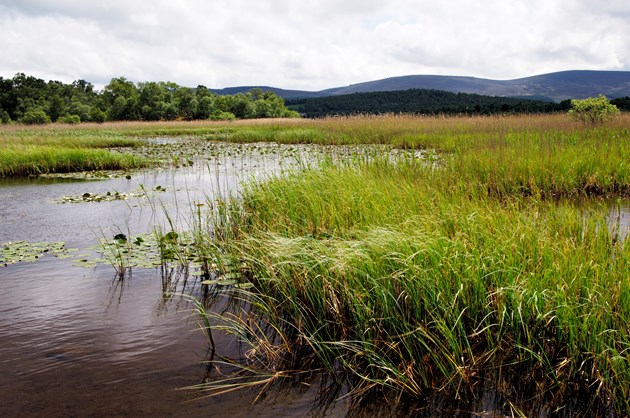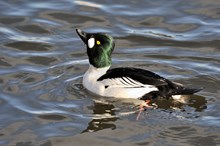17 June, 2021
Boaters asked to stay away from Muir of Dinnet loch to protect birds

NatureScot is asking all visitors to the Muir of Dinnet National Nature Reserve – which receives about 80,000 visitors a year – to stay off Loch Kinord at this sensitive time of year for nesting birds, beginning today (17 June).
In April this year, NatureScot asked those planning to use the water for recreation to move elsewhere if the loch was busy. But after continued, significant disturbance of nesting birds, the organisation is now urging people to stay off the water until the bird breeding season is over.
There has been a sharp increase in the number of people going out on the water this year in canoes, kayaks, inflatables and paddle-boards, as well as wild swimming. Human activity on this small loch can disturb protected wildfowl like goldeneye, and may lead to ducklings becoming separated from their parents and dying.
Monitoring data shows that early morning bird counts on the loch are significantly higher than those taken later in the day when visitors are present on the water.
Gavin Clark, Tayside & Grampians operations manager, said:
“We want everyone to have a wonderful time visiting the reserve, but we're asking visitors to remember that Muir of Dinnet is first and foremost a nature reserve and wildlife has to take priority.
“Individually, someone going out on the water may not be aware of any problem, but put that together with a number of other people doing the same thing and it adds up to a significant disturbance problem for the birds. Our priority must be protecting the wildlife on the nature reserve, and we hope this change will salvage the 2021 bird breeding season on the loch.”
There will be signs placed at all main entry points to the nature reserve, as well as information on the NatureScot website and a new leaflet explaining the changes.
A second, smaller loch on the reserve, Loch Davan, has been under similar restrictions since 2009 because of bird disturbance and the potential for damage to sensitive habitats.
NatureScot will continue to monitor visitor numbers and behaviour, as well as bird counts. Before the 2022 season, all the evidence will be considered to determine whether the same visitor guidance will remain in force.
In the spring, NatureScot held a stakeholder and community consultation about loch usage. Feedback ranged from those concerned about increased disturbance all over the reserve with elevated levels of camping, fires, litter and dogs off lead to those concerned about restrictions on their activities.
For more information on responsible outdoor access in Scotland, see www.outdooraccess-scotland.scot.
Contact information
- Name
- NatureScot Media
- Telephone
- 0131 316 2655
- media@nature.scot
Notes to editors
Muir of Dinnet is a Site of Special Scientific Interest for its breeding bird and freshwater interests. It is also a Special Protection Area for its non-breeding wildfowl assemblage and a Special Area of Conservation for otter. All wild birds and their nests are protected under the Wildlife and Countryside Act, and some species such as goldeneye, which is present on the reserve, are subject to additional protection from intentional or reckless disturbance. The assemblage of breeding birds SSSI feature regularly includes species such as great-crested and little grebes, mute swan, water rail, spotted crake and sedge warbler, along with wigeon, goosander and goldeneye. In addition, the lochs are also an important feeding site for osprey, which nest elsewhere in Deeside.
For nature reserves, the Scottish Outdoor Access Code states:
Access rights extend to these places but remember that they are carefully managed for nature conservation and to safeguard rare animals and plants. Take care to avoid damaging the site or disturbing its wildlife, or interfering with its management or enjoyment by others. Depending on your activity, you might be requested to follow a specific route or to avoid exercising access rights in a specific area. Following such local guidance can help to safeguard the natural heritage of these areas.
There are 43 National Nature Reserves in Scotland. These are special places that look after some of the best of Scotland’s nature on behalf of everyone who lives or visits Scotland, and they provide unique opportunities to visit, enjoy and learn more about Scotland’s nature. For more information, see see https://www.nature.scot/enjoying-outdoors/scotlands-national-nature-reserves
NatureScot is Scotland's nature agency. We work to enhance our natural environment in Scotland and inspire everyone to care more about it. Our priority is a nature-rich future for Scotland and an effective response to the climate emergency. For more information, visit our website at www.nature.scot or follow us on X at https://x.com/NatureScot
’S e NatureScot buidheann nàdair na h-Alba. Bidh sinn a’ neartachadh àrainneachd na h-Alba agus a’ brosnachadh dhaoine gu barrachd suim a chur ann an nàdar. Tha e mar phrìomhachas againn gum bi nàdar na h-Alba beairteach agus gun dèilig sinn gu h-èifeachdach le èiginn na gnàth-shìde. Tha an tuilleadh fiosrachaidh aig www.nature.scot no air X aig https://x.com/NatureScot



